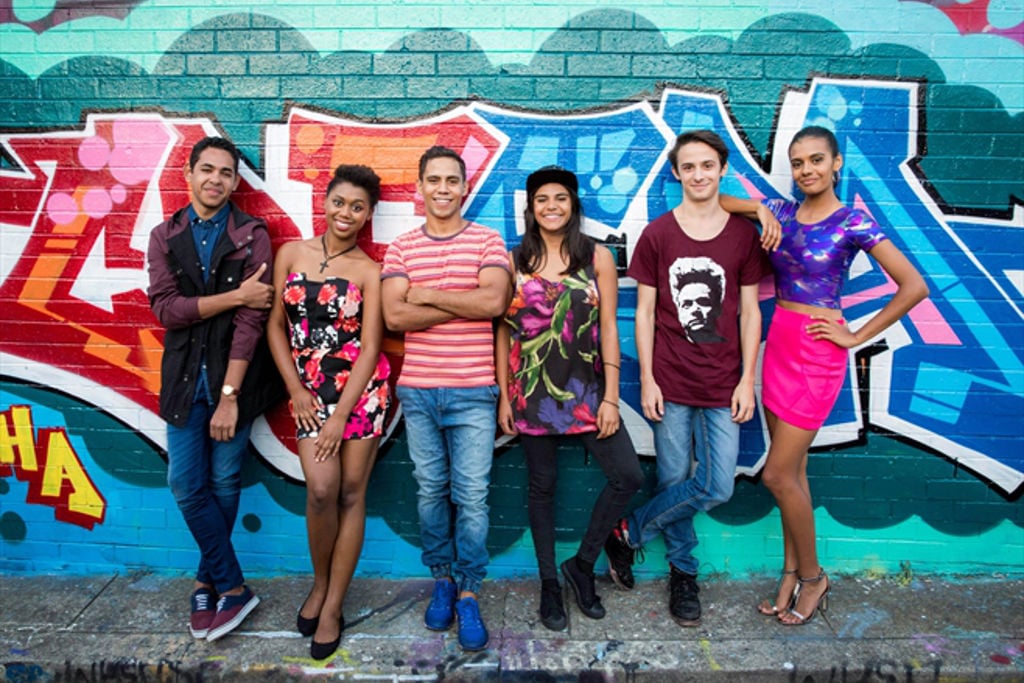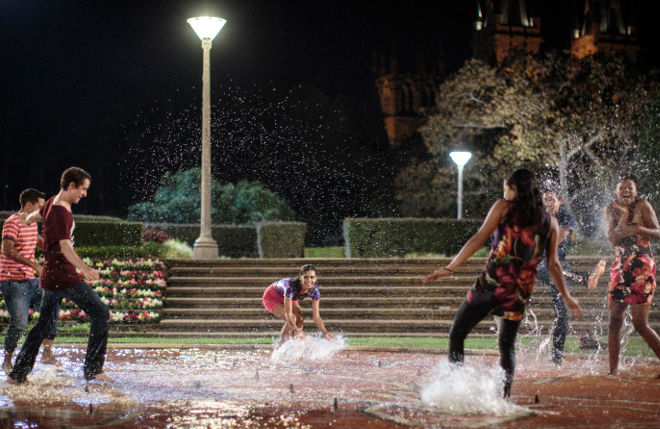On ABC’s New Indigenous Drama ‘Ready For This’, And Why Aussie Teen TV Has Always Ruled At Diversity
ABC3’s new series follows a great tradition of diversity in Australian teen dramas, so YAY, LET’S TALK ABOUT HEARTBREAK HIGH!

Teen TV has always had a legitimacy issue. Somehow people tend to believe that programs made about young people and their feelings do not hold as much artistic weight as shows made about hacking and meth.
This opinion is boring, but convincing the non-believers is a waste of time. It’s their loss: they’ll never get to enjoy shows like Ready For This.
Ready For This, which premiered last night on ABC3, is a new series from the creators of Dance Academy and Redfern Now. It’s also Australia’s first drama about indigenous kids made specifically for a mainstream teenage audience. The show follows a bunch of kids with different talents who travel to a Sydney boarding house from across the country, to further hone their skills. Spoiler: angst and kissing ensues!
Why Should I Watch This Show?
Ava (Majeda Beatty) is singer and musician who is terrified by her new surroundings and is immediately homesick for the Torres Strait Islands. Dylan (Liam Talty) is a classical violist who really dreams of making electronic music. Zoe (Madeleine Madden) is a runner who keeps a poster of Cathy Freeman on her wall. Levi (Aaron McGrath) is an aspiring AFL player, whose family is involved in a mysterious feud with Zoe’s family. Lily (Leonie Whyman) was just sent to Sydney because her dad was sick of her getting in trouble1.
Levi likes Zoe. A white kid called Reese (Christian Byers) likes Lily. Lily almost runs away with a Bondi hipster. If you think this sounds a bit like a Fame/Skins/Degrassi hybrid, then you are correct.

Ready For This is committed to the tropes of teen TV. Some of the kids become instant outsiders at school, while others stand at the top of the social hierarchy, and this is treated as important. They act tough and sarcastic, but still worry about how they’re being perceived by their peers, and their parents. The regular character archetypes — the jock, the geek, the cool girl, the high achiever — are all represented.
But of course, this is an ABC show about five indigenous kids, which means it tackles much more than your standard Dawson’s Creek fare. Ready For This may be one of the first to focus primarily on the indigenous teenage experience, but Australian teen TV has been exploring racial diversity for years.
You Heard of Heartbreak High?
Heartbreak High is still considered one of Australia’s most complex teen dramas. It tackled issues as far-reaching as freedom of speech and the republic debate, to domestic violence and sexual assault — back when the Twist kids were just trying to figure out how to save the lighthouse.
It first aired in 1994 on Channel Ten before being picked up by the ABC, at a time when conversations about Australia’s fluid national identity – particularly in relation to reconciliation, and parts of society that were routinely discriminated against – were gaining momentum. (It’s worth noting too that this was the year that The Adventures of Priscilla, Queen of the Desert and Muriel’s Wedding became hits, signaling a shift in the conversation about the ‘right’ way to represent Australia in popular culture, and what that even meant.)
Heartbreak High went for seven seasons, gave a lot of Neighbours, Home and Away and Underbelly actors their first jobs, and very deliberately addressed issues of race. The show was set at a high school in a multicultural suburb of Sydney, and challenged the ‘default’ white male experience of most TV dramas.
The kids were Greek, Italian, Vietnamese, Taiwanese, Lebanese and South American, and many of them came from non-English speaking households. They clashed with migrant parents and clashed with each other (this was pre-Nick Giannopoulos trying to reclaim ‘wog’, and the word is continually used to cutting effect). But Heartbreak High asserted that despite their cultural differences, these kids were essentially the same, sharing the same ups and downs of adolescence. Given the most popular Australian shows on TV in 1994 were Blue Heelers and Hey Hey, It’s Saturday, this was a pretty drastic departure from the usual whitewashed dramas (nothing much has changed, though).
In Heartbreak High, it didn’t matter where your parents are from, as long as you really liked saying “rack off”. And boy oh boy, did they like saying rack off.
Australia’s Teen TV Tradition
The diversity we see in the Australian teen genre operates in two ways: it interrogates racism and privilege as an avenue to educate the audience; or it provides representation for demographics who have previously been denied it on TV.
The casual diversity of shows like Crash Zone (a show about teen gamers) and Short Cuts (a show about kids in a media class) was never really mentioned, because it was just presented as normal. In Lockie Leonard, Lockie’s best friend Egg is an indigenous kid whose race is not the defining aspect of his character; the fact that he is a metal head is. Dance Academy also features a diverse cast who seem to be constantly falling in and out of love with each other, but race doesn’t really factor into their dating decisions.
Sometimes having a racially diverse cast whose diversity is never mentioned is just as powerful as Heartbreak High’s head-on approach.
Ready For This examines what it means to be an indigenous young person in Australia in 2015, while asserting that there is not one uniform experience of non-whiteness. To Levi, whose family moved from Darwin to Sydney long ago, issues of warring families and his family’s ancestry seem distant. Zoe senses her own difference immediately, lamenting that she has the “wrong clothes, wrong accent”, and will never fit in in Sydney. When Reese asks if Lily and Levi know each other, she replies, “What, you think all black fellas know each other? So racist” — just to watch him squirm and fall over himself to apologise. Ava talks to her friend from back home and worries that people will think that she’s “bush black”. Each kid imagines his or her non-whiteness in a different way, because that’s normal.
Of course not every show in the genre shows that same commitment to diverse casting and challenging storylines about race. But, when you look at how race is represented in many of these shows compared to the highest rating Australian primetime dramas of the last twenty years – your Packed to the Rafters, Blue Heelers, Offspring, All Saints, etc. – it appears like teen TV is unusual in its exploration of the gamut of our multicultural identity.
So Why Is Australian Teen TV Interested in Depicting Diversity?
Besides the fact that confronting ‘edgy’ issues like racism is teen TV’s bread and butter, there’s something in the tradition of adolescent drama that specifically lends itself to this particular issue.
At its core, teen TV is just about the melodramatic time between childhood and adulthood that allows characters to make (bad) grown-up decisions with childlike judgment. Through these decisions and relationships, these characters get closer to figuring out who they actually are as people. This is the real tension of teen TV. Was The O.C really about Ryan and Marissa making out and getting in trouble, or was it about confused kids forging their disruptive identities in opposition to the forces around them?
This all takes on a new meaning in the Australian context, too. Maybe the ways in which the kids in Ready For This and Heartbreak High struggle with their identities is similar to the way Australians grapple with our own national identity. Just as teen TV characters have to work out who they are in the context of gender, sexuality, race and class, Australians similarly have competing factors in defining what ‘Australian’ actually means. The confusion of adolescence can be reflected in the confusion of a young country who hasn’t really figured out who it is yet. There is a disconnect between what we are told that we are (the Anglo Aussie battler) and what we actually are, even though intellectually we know that Australia is a country built on immigration and a quarter of our population was born overseas. It’s mega cheesy, but The Seekers said it most succinctly: we are one, but we are many. As Australians, we are all the product of many competing fragments, but essentially we’re still the same. The teens in these shows struggle to harness contradictory elements that make them, in the same way that Australia struggles to build a cohesive national identity. The trick is holding onto what binds us while still being able to celebrate our differences.
There are things about Ready For This that may be familiar or unfamiliar to you, but there are certain moments that we can all identify with regardless of race; from profound things like feeling like an outsider and the fear of leaving home, to the silly shared identification we have from recognising that Christine Anu is playing the boarding house caretaker, that Levi has the iconic 1993 photo of Nicky Winmar pointing at his chest on his bedroom wall, and that the song that Ava belts out by herself in the music room is by Tame Impala. All in all, teen TV continues to offer a pretty neat metaphor for the construction of our national identity.
–
Ready For This airs on ABC3, on Mondays at 6:20pm. Watch the first episode on ABC iView.
–
Sinead Stubbins is a writer from Melbourne who has done stuff for Yen, frankie, Smith Journal and Elle. She tweets from @sineadstubbins

